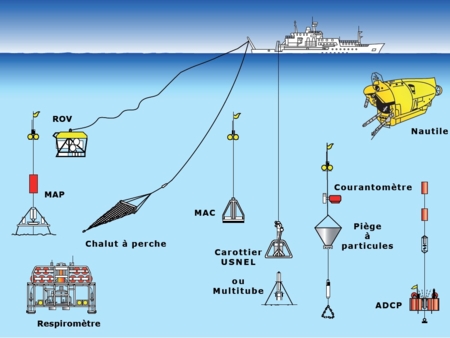New host-virus systems from deep sea hydrothermal vents
Our knowledge of the viral diversity associated to microorganisms inhabiting the deep-sea hydrothermal vents is still limited. Only a few studies have focused on viral abundance and impact on microbial mortality within these ecosystems. A limited number of viruses (6 bacterioviruses and 2 archaeoviruses) were isolated from these environments and characterized. Two viruses associated to hyperthermophilic anaerobic Archaea, from the Thermococcales order, have been described in our laboratory. In order to deepen our knowledge on the viral diversity of these extreme environments, we have extended our investigation to the bacterial order of Thermotogales. This order is composed of anaerobic chemoorganotrophic bacteria that are, for the most part, hyper/thermophilic. Numerous lateral gene transfers have contributed to the evolutionary history of the Thermotogales, implying the potential involvement of viruses. Here, we will report the characterization of two new siphoviruses MCV1 and MCV2 that infect two strains of Marinitoga camini. Those bacterial strains were isolated from two deep-sea hydrothermal vents sites (Menez Gwen and Lucky strike) in the Mid Atlantic Ridge. These viruses are temperate with a high basal production of virions (>107 virions/mL). Comparative genomics with MPV1, a virus isolated from M. piezophila, was performed and show that those bacterioviruses share numerous similarities. A set of “core genes” shared by all these three viruses was identified and includes proteins involved in DNA metabolism, head and tail assembly and lysogenic cycle. Shared hypothetical proteins were also identified, suggesting that these unknown proteins probably provide important functions for these viruses. Interestingly, for genes with blastp matches in Genbank, over 60% have their top matches, outside the Thermotoga, to genes from Firmicutes and bacterioviruses associated to Firmicutes. We also analyzed the genome of Thermosipho sp. 1244 and studied his CRISPR-cas system. Our results indicated that this Thermosipho strain, with a complete and functional CRISPR-cas system, had already been infected by MCV1, MCV2 or a similar virus. The analyses presented here extend our knowledges about these newly discovered viruses in the deeply branching bacterial phylum Thermotogae. This bacterial order and associated mobile genetic elements are significant for addressing long-term evolutionary adaptation to fluctuant and extreme physicochemical conditions.







